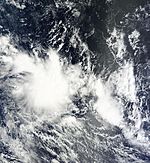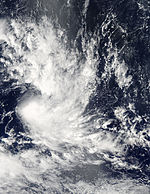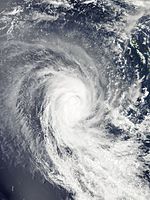2014–15 South Pacific cyclone season
| 2014–15 South Pacific cyclone season | |
|---|---|
 Season summary map | |
| Seasonal boundaries | |
| First system formed | November 21, 2014 |
| Last system dissipated | Season currently active |
| Strongest storm | |
| Name | Ola |
| • Maximum winds | 150 km/h (90 mph) (10-minute sustained) |
| • Lowest pressure | 955 hPa (mbar) |
| Seasonal statistics | |
| Total disturbances | 8 |
| Total depressions | 6 |
| Tropical cyclones | 2 |
| Severe tropical cyclones | 1 |
| Total fatalities | Unknown |
| Total damage | Unknown |
| Related articles | |
The 2014–15 South Pacific cyclone season is the period of the year when most tropical cyclones form within the South Pacific Ocean to the east of 160°E. The season officially runs from November 1, 2014 to April 30, 2015, however a tropical cyclone could form at any time between July 1, 2014 and June 30, 2015 and would count towards the season total. During the season, tropical cyclones will be officially monitored by the Regional Specialized Meteorological Center (RSMC) in Nadi, Fiji and the Tropical Cyclone Warning Centers in Brisbane, Australia and Wellington, New Zealand. The United States Armed Forces through the Joint Typhoon Warning Center (JTWC) will also monitor the basin and issue unofficial warnings for American interests. RSMC Nadi attaches a number and an F suffix to tropical disturbances that form in or move into the basin while the JTWC designates significant tropical cyclones with a number and a P suffix. RSMC Nadi, TCWC Wellington and TCWC Brisbane all use the Australian Tropical Cyclone Intensity Scale and estimate windspeeds over a period of ten minutes, while the JTWC estimated sustained winds over a 1-minute period, which are subsequently compared to the Saffir–Simpson Hurricane Scale (SSHS).
Seasonal forecasts
| Source/Record | Tropical Cyclone |
Severe Tropical Cyclone |
Actual activity |
Ref |
|---|---|---|---|---|
| Record high: | 1997–98: 16 | 1982–83:10 | — | [1] |
| Record low: | 2003–04: 3 | 2008–09: 0 | — | [1] |
| Averages: | 8.5 | — | — | [2] |
| NIWA | 8-12 | 4 | 1 | [3] |
| RSMC Nadi | 6-10 | 2-4 | 1 | |
| Region | Chance of above average |
Average number |
Actual activity | |
| Southern Pacific | 48% | 15 | 1 | |
| Western South Pacific | 56% | 8 | 0 | |
| Eastern South Pacific | 47% | 11 | 1 | |
| Source:BOM's Seasonal Outlooks for Tropical Cyclones.[4] | ||||
Ahead of the cyclone season, RSMC Nadi, TCWC Wellington, the Australian Bureau of Meteorology (BoM), the New Zealand National Institute of Water and Atmospheric Research (NIWA) and various other Pacific Meteorological services, all contributed towards the Island Climate Update tropical cyclone outlook that was released during October 2014.[3] The outlook took into account the ENSO neutral conditions that had been observed across the Pacific and analogue seasons that had ENSO neutral and weak El Nino conditions occurring during the season.[3] The outlook called for a near average number of tropical cyclones for the 2014–15 season, with eight to twelve named tropical cyclones, to occur between 135°E and 120°W compared to an average of 10.[3] At least four of the tropical cyclones were expected to become category 3 severe tropical cyclones, while three could become category 4 severe tropical cyclones, they also noted that a Category 5 severe tropical cyclone was unlikely to occur.[3] In addition to contributing towards the Island Climate Update outlook, RSMC Nadi and the BoM issued their own seasonal forecasts for the South Pacific region.[2][4]
The BoM issued 3 seasonal forecasts for the Southern Pacific between 142.5°E and 120°W, one for the Western Southern Pacific region between 142.5°E and 165°E and one for the Eastern Southern Pacific region between 165°E and 120°W.[4] They predicted that the region as a whole, would experience near average tropical cyclone activity during the coming season with a 55% chance of it being above average.[4] The Western region was predicted to have 39% chance of being above average while the Eastern region had a 55% chance of being above average.[4] Within their outlook RSMC Nadi predicted that between six and ten tropical cyclones, would occur within the basin compared to an average of around 8.5 cyclones.[2] At least two of the tropical cyclones were expected to become category 3 severe tropical cyclones, while 1-2 might intensify into a category 4 or 5 severe tropical cyclones.[2] They also reported that the tropical cyclone genesis trough was expected to be located near to and to the east of the International Dateline.[2] This was based on the expected and predicted ENSO conditions, and the existence of the Pacific warm pool of sub-surface temperature anomalies in this region.[2]
Risk forecasts
Both the Island Climate Update and RSMC Nadi's tropical cyclone outlooks assessed the risk of a tropical cyclone affecting a certain island or territory.[2][3] As the tropical cyclone genesis trough of low pressure was expected to be located near to and to the east of the International Dateline, normal or slightly above normal activity was expected for areas near the dateline.[2][3] The Island Climate Update Outlook predicted that Vanuatu and New Caledonia had a reduced chance of being affected by multiple tropical cyclones.[3] The Northern Cook Islands, Fiji, Papua New Guinea, Tonga, Wallis and Futuna, the Solomon Islands, Northern New Zealand and French Polynesia's Austral and Society Islands were all predicted to have a normal chance of being affected by a tropical cyclone or ex tropical cyclone.[3] They also predicted that Niue, Samoa, Tokelau, Tuvalu and the Southern Cook Islands had an elevated chance while French Polynesia's Tuamotu Archipelago and Marquesas Islands, Kiribati and the Pitcairn Islands, had an unlikely chance of being affected by a tropical cyclone.[3] RSMC Nadi's outlook predicted that Wallis and Futuna, Tuvalu, Samoa, Niue, Tonga, Vanuatu, the Southern Cook Islands and the Solomon Islands had a high chance of being affected by a tropical cyclone.[2] Fiji, French Polynesia, New Caledonia and the Northern Cook Islands and had a moderate chance of being affected by a tropical cyclone while Kiribati had a low chance.[2] Because of its proximity to the warm pool and genesis area, RSMC Nadi noted that Tokelau had a low to moderate risk of being affected by a tropical cyclone.[2] RSMC Nadi also predicted that there was an increased risk of severe tropical cyclones, affecting the region this year when compared to the previous season.[5] There was a high chance of Tuvalu, Samoa, Niue, Tonga, the Southern Cook Islands, Vanuatu and the Solomon Islands being affected by a severe tropical cyclone.[5] The chances of Fiji, New Caledonia, the Northern Cook Islands and French Polynesia being affected by a severe tropical cyclone were moderate while Kiribati, Tokelau and Wallis and Futuna had a low risk.[5]
Seasonal summary

Storms
Tropical Depression 01F
| Tropical depression (Australian scale) | |
| Duration | November 21 – November 26 |
|---|---|
| Peak intensity | Winds not specified; 1003 hPa (mbar) |
During November 21, RSMC Nadi reported that a tropical disturbance had developed about 375 km (235 mi)* to the north-west of Mata-Utu, on the French territory of Wallis and Futuna.[6] Over the next couple of days atmospheric convection surrounding the system gradually became better organised as it moved south-westwards before it was classified as a tropical depression during November 23.
Tropical Depression 03F
| Tropical depression (Australian scale) | |
| Duration | December 20 – December 26 |
|---|---|
| Peak intensity | 55 km/h (35 mph) (10-min); 998 hPa (mbar) |
Late on December 20, RSMC Nadi reported that Tropical Disturbance 03F, had developed within an area of low vertical windshear to the north-northeast of Pago Pago, American Samoa.[7]
Tropical Depression 04F
| Tropical depression (Australian scale) | |
| Duration | December 21 – December 24 |
|---|---|
| Peak intensity | Winds not specified; 1000 hPa (mbar) |
During December 21, RSMC Nadi reported that a tropical disturbance had developed about 275 km (170 mi)* northeast of Aitutaki in the Cook Islands. It moved globally Southeast as a tropical depression. It triggered heavy rain in French Polynesia's Society Islands and in the Northern Cook Islands. It dissipated to the south-east of Tahiti on December 24.
Tropical Depression 05F
| Tropical depression (Australian scale) | |
| Duration | December 23 – December 29 |
|---|---|
| Peak intensity | Winds not specified; 1000 hPa (mbar) |
During December 23, RSMC Nadi reported that a tropical disturbance had developed about 290 km (180 mi)* northwest of Niuafo'ou, the most northerly island in the kingdom of Tonga.
Tropical Cyclone Niko
| Category 2 tropical cyclone (Australian scale) | |
| Tropical storm (SSHWS) | |
| Duration | January 19 – January 25 |
|---|---|
| Peak intensity | 100 km/h (65 mph) (10-min); 982 hPa (mbar) |
This section needs expansion. You can help by adding to it. (January 2015) |
During January 19, RSMC Nadi reported that Tropical Disturbance 06F had developed, to the northeast of Papeete on the French Polynesian island of Tahiti.[8] The system lay under an upper level ridge of high pressure in an environment, which was favorable for further development with low to moderate vertical windshear.[8][9] As a result the organisation of the atmospheric convection surrounding the system significantly improved, while the systems low level circulation centre rapidly consolidated over the next day. As a result late on January 20, the JTWC initiated advisories on the system an assigned it the designation 07P. RSMC Nadi subsequently reported that the system had developed into a category 1 tropical cyclone and named it Niko.
Severe Tropical Cyclone Ola
| Category 3 severe tropical cyclone (Australian scale) | |
| Category 2 tropical cyclone (SSHWS) | |
| Duration | January 29 – Currently active |
|---|---|
| Peak intensity | 150 km/h (90 mph) (10-min); 955 hPa (mbar) |
During January 29, RSMC Nadi reported that Tropical Depression 09F had moved into the basin, from the Australian region to the northwest of New Caledonia.[10] The system was moving towards the east-northeast and lied within an area of low vertical wind shear underneath an upper level ridge of high pressure.[10] During January 30 the JTWC initiated advisories on the system and assigned it the designation Tropical Cyclone 10P. RSMC Nadi subsequently reported that the system had become a category 1 tropical cyclone and named it Ola. Over the next two days the system gradually intensified further and became a category 3 severe tropical cyclone early on February 1. on February 2, the JTWC classified Ola as Category 2 strong severe tropical cyclone.
Other systems
During December 16, RSMC Nadi reported that Tropical Disturbance 02F had developed about 360 km (225 mi)* northeast of Niue.[11] The system was last noted by RSMC Nadi during the following day, as it was suspected to have become an extratropical cyclone.[12] Late on January 27, RSMC Nadi reported that Tropical Disturbance 08F had developed about 275 km (170 mi)* to the southeast of Apia, Samoa.[13]
Storm names
Within the Southern Pacific a tropical depression is judged to have reached tropical cyclone intensity should it reach winds of 65 km/h, (40 mph) and it is evident that gales are occurring at least halfway around the center. With tropical depressions intensifying into a tropical cyclone between the Equator and 25°S and between 160°E - 120°W named by the RSMC Nadi. However should a tropical depression intensify to the south of 25°S between 160°E and 120°W it will be named in conjunction with RSMC Nadi by TCWC Wellington. Should a tropical cyclone move out of the basin and into the Australian region it will retain its original name.[14]
|
|
Season effects
This table lists all the storms that developed in the South Pacific to the east of longitude 160°E during the 2014–15 season. It includes their intensity on the Australian tropical cyclone intensity scale, duration, name, landfalls, deaths, and damages. All data is taken from RSMC Nadi and/or TCWC Wellington, and all of the damage figures are in 2014 USD.
| Name | Dates | Peak intensity | Areas affected | Damage (USD) |
Deaths | Refs | ||
|---|---|---|---|---|---|---|---|---|
| Category | Wind speed | Pressure | ||||||
| 01F | November 21 – 26 | Tropical depression | Not Specified | 1003 hPa (29.62 inHg) | Tokelau, Tuvalu, Wallis and Futuna, Samoa, American Samoa | Minimal | None | |
| 02F | December 16 – 17 | Tropical disturbance | Not Specified | 1007 hPa (29.74 inHg) | None | None | None | |
| 03F | December 20 – 26 | Tropical depression | 55 km/h (35 mph) | 998 hPa (29.47 inHg) | Northern Cook Islands | None | None | |
| 04F | December 21 – 24 | Tropical depression | Not Specified | 1000 hPa (29.53 inHg) | Northern Cook Islands, French Polynesia | None | None | |
| 05F | December 23 – 29 | Tropical depression | Not Specified | 1000 hPa (29.53 inHg) | Tokelau, Samoa, American Samoa | None | None | |
| Niko | January 19 – 25 | Category 2 tropical cyclone | 100 km/h (65 mph) | 982 hPa (29.00 inHg) | French Polynesia | Minimal | None | |
| 08F | January 27 – 30 | Tropical disturbance | Not Specified | 1000 hPa (29.53 inHg) | None | None | None | |
| Ola | January 29 – Currently active | Category 3 severe tropical cyclone | 150 km/h (90 mph) | 955 hPa (28.20 inHg) | New Caledonia | None | None | |
| Season aggregates | ||||||||
| 8 systems | November 21 – Currently active | 150 km/h (90 mph) | 955 hPa (28.20 inHg) | Minimal | None | |||
See also
- List of South Pacific cyclone seasons
- Atlantic hurricane seasons: 2014, 2015
- Pacific hurricane seasons: 2014, 2015
- Pacific typhoon seasons: 2014, 2015
- North Indian Ocean cyclone seasons: 2014, 2015
- 2014–15 South-West Indian Ocean cyclone season
- 2014–15 Australian region cyclone season
References
- ^ a b Climate Services Division; RSMC Nadi — Tropical Cyclone Centre (October 26, 2010). Tropical Cyclone Guidance for Season 2010/11 for the Fiji and the Southwest Pacific (Report). Fiji Meteorological Service. Archived from the original (PDF) on February 27, 2012. Retrieved July 10, 2012.
- ^ a b c d e f g h i j k RSMC Nadi – Tropical Cyclone Centre (October 15, 2014). "2014/15 Tropical Cyclone Season Outlook in the Regional Specialised Meteorological Centre Nadi – Tropical Cyclone Centre Area of Responsibility". Fiji Meteorological Service. p. 2. Archived from the original (PDF) on October 27, 2014. Retrieved October 27, 2014.
{{cite web}}: Unknown parameter|deadurl=ignored (|url-status=suggested) (help) - ^ a b c d e f g h i j "Southwest Pacific Tropical Cyclone Outlook: Near average tropical cyclone numbers for the region is likely, with increased activity from February onward". The National Institute of Water and Atmospheric Research. October 15, 2014. Retrieved October 22, 2014.
- ^ a b c d e National Climate Centre (October 15, 2014). "2014–2015 South Pacific Tropical Cyclone Season Outlook". Australian Bureau of Meteorology. Archived from the original on October 15, 2014. Retrieved October 15, 2014.
{{cite web}}: Unknown parameter|deadurl=ignored (|url-status=suggested) (help) - ^ a b c Kean, Francis (October 24, 2014). "Moderate Chances For Tropical Cyclones This Season In Fiji" (Press release). Fiji Meteorological Service. Archived from the original (PDF) on October 27, 2014. Retrieved October 27, 2014.
{{cite press release}}: Unknown parameter|deadurl=ignored (|url-status=suggested) (help) - ^ RSMC Nadi — Tropical Cyclone Centre (November 21, 2014). "Tropical Disturbance Summary November 21, 2014 06z". Fiji Meteorological Service. Archived from the original on November 21, 2014. Retrieved November 21, 2014.
- ^ RSMC Nadi — Tropical Cyclone Centre (December 20, 2014). "Tropical Disturbance Summary December 20, 2014 21z". Fiji Meteorological Service. Archived from the original on December 25, 2014. Retrieved December 25, 2014.
- ^ a b RSMC Nadi — Tropical Cyclone Centre (January 19, 2015). "Tropical Disturbance Summary January 19, 2015 23z". Fiji Meteorological Service. Archived from the original on January 20, 2015. Retrieved January 21, 2015.
- ^ Joint Typhoon Warning Center (January 20, 2015). "Significant Tropical Weather Outlook for the Western and South Pacific Ocean January 20, 2015 12z". United States Navy, United States Airforce. Archived from the original on January 21, 2015. Retrieved January 21, 2015.
- ^ a b RSMC Nadi — Tropical Cyclone Centre (January 29, 2015). "Tropical Disturbance Advisory January 29, 2015 12z". Fiji Meteorological Service. Archived from the original on January 31, 2015. Retrieved January 29, 2015.
- ^ RSMC Nadi — Tropical Cyclone Centre (December 16, 2014). "Tropical Disturbance Summary December 17, 2014 09z". Fiji Meteorological Service. Archived from the original on December 25, 2014. Retrieved December 25, 2014.
- ^ RSMC Nadi — Tropical Cyclone Centre (December 17, 2014). "Tropical Disturbance Summary December 17, 2014 06z". Fiji Meteorological Service. Archived from the original on December 25, 2014. Retrieved December 17, 2014.
- ^ RSMC Nadi — Tropical Cyclone Centre (January 27, 2015). "Tropical Disturbance Summary January 27, 2015 23z". Fiji Meteorological Service. Archived from the original on January 28, 2015. Retrieved January 30, 2015.
- ^ RA V Tropical Cyclone Committee (December 12, 2012). Tropical Cyclone Operational Plan for the South-East Indian Ocean and the Southern Pacific Ocean 2012 (PDF) (Report). World Meteorological Organization. Retrieved December 14, 2012.













